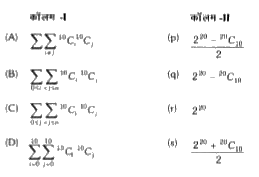यदि (1+x)14 के विस्तार में Tr,Tr+1,Tr+2 के गुणांक समांतर श्रेणी में हों, तो r=
6
7
8
9
The correct Answer is:D
Step by step video, text & image solution for यदि (1+x)^(14) के विस्तार में T_(r),T_(r+1),T_(r+2) के गुणांक समांतर श्रेणी में हों, तो r= by Maths experts to help you in doubts & scoring excellent marks in Class 12 exams.
Topper's Solved these Questions
- BOOK - ERRORLESS HINDICHAPTER - द्विपद प्रमेय तथा गणितीय आगमन EXERCISE - EXERCISE86videos
द्विपद प्रमेय तथा गणितीय आगमन
- BOOK - ERRORLESS HINDICHAPTER - द्विपद प्रमेय तथा गणितीय आगमन EXERCISE - JEE Advanced (More than one correct answers)11videos
द्विपद प्रमेय तथा गणितीय आगमन
- BOOK - ERRORLESS HINDICHAPTER - द्विपद प्रमेय तथा गणितीय आगमन EXERCISE - JEE Advanced (Matrix Math type questions)5videos
द्विपद प्रमेय तथा गणितीय आगमन
- BOOK - ERRORLESS HINDICHAPTER - त्रिविमीय निर्देशांक ज्यामिति EXERCISE - JEE ADVANCED (Matrix Match type questions)4videos
त्रिविमीय निर्देशांक ज्यामिति
- BOOK - ERRORLESS HINDICHAPTER - निश्चित समाकलन एवं वक्रों से घिरा क्षेत्रफल EXERCISE - JEE ADVANCED (Matrix Match type questions)9videos
निश्चित समाकलन एवं वक्रों से घिरा क्षेत्रफल
Similar Questions
वह बड़े से बड़ा पूर्णांक जो संख्या 101100−1 को विभाजित करता है, है
07:09View Solutionधनात्मक पूर्णांक n के लिए माना a(n)=1+12+13+14+...+1(2n)−1 तब
03:18View Solutionनिम्नलिखित कॉलम I को कॉलम II से मिलाये
 04:08View Solution
04:08View Solutionमाना निम्न रैखिक समीकरण है ax+by+cz=0,bx+cy+oz=0,cx+ay+bz=0 कॉलम । में दी गयी स्थितियों/व्यंजकों का कॉलम ॥ में दिए गए वक्तव्यों से सुमेल करें
 05:39View Solution
05:39View Solutionकॉलम I में दिए गए समाकलनों का कॉलम II में दिए गए मानों से सुमेल करे
कॉलम Iकॉलम II(A)∫1−1dx1+x2(p)12log(23)(B)∫10dx√1−x2(q)2log(23)(C)∫32dx1−x2(r)π3(D)∫21dxx√x2−1(s)π207:33View SolutionIf t_(r)=2^((r)/(3))+2^(-(r)/(3)), then sum_(r=1)^(100)(t_(r))^(3)-3sum_(r=1)^(100)(t_(r))+1=
02:08View SolutionShow that the relation R defined in the set A of all triangles as R={(T1,T2):T1 is similar to T2}, is equivalence relation.
05:26View SolutionIf t1=1,tr−tr−1=2r−1,r≥2, find n∑r=1tr.
02:56View SolutionLet the rth term tr of a series is given by tr=r1+r2+r4, the value of limn→∞n∑r=1tr is
06:02View SolutionIf (1 +x)^(14) Expansion of T_(r), T_(r+1), T_(r+2) If the coefficient of k is in the parallel range, find the value of r.
09:35View SolutionLet the rth term, tr, of a series is given by : tr=r1+r2+r4. "Then" limn→∞n∑r=1tr equals :
06:28View SolutionShow that the relation R defined in the set A of all triangles as R={(T1,T2):T1 is similar to T2}, is equivalence relation.
03:53View SolutionLet Tr be the rth term of a sequence, for r=1,2,3,......... If 3Tr+1=Tr and T7=1243 then the value of ∞∑r=1(Tr.Tr+1) is :
02:33View SolutionThe rth term tr of a series is given by tr=rr4+r2+1 then limn→∞n∑r=1tr=
04:48View SolutionR t_(r) is Where t_(r)=(r)/(1+r^(2)+r^(4)) Then lim_(n to oo) sum_(t=1)^(n)t_(r) is
04:02View Solution

